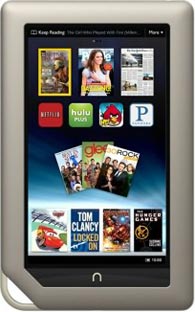 Barnes & Noble is basking in the glory of a significant stock bump after Microsoft infused its new e-reader subsidiary with $300 million or more in
investment. The Microsoft partnership has everyone speculating about the deal’s effect on future Nooks. Will they be powered by Win 8? Is this the move to put Microsoft and its last-one-in
tablet strategy into play?
Barnes & Noble is basking in the glory of a significant stock bump after Microsoft infused its new e-reader subsidiary with $300 million or more in
investment. The Microsoft partnership has everyone speculating about the deal’s effect on future Nooks. Will they be powered by Win 8? Is this the move to put Microsoft and its last-one-in
tablet strategy into play?
Well, we don’t know the answers to any of these questions yet, and according to the
interview with B&N CEO William Lynch and Fortune, we may not know for a while.
Wrong question. The more immediate and interesting revelation was that B&N plans to
put NFC chips in its Nooks and start conversations between books and devices. Lynch says in the interview: “We're going to start embedding NFC chips into our Nooks. We can work with the
publishers so they would ship a copy of each hardcover with an NFC chip embedded with all the editorial reviews they can get on BN.com. And if you had your Nook, you can walk up to any of our
pictures, any [sic] our aisles, any of our bestseller lists, and just touch the book, and get information on that physical book on your Nook and have some frictionless purchase experience. That's
coming, and we could lead in that area.”
Now this would be something to see. With Barnes & Noble’s leverage with publishers, they surely could persuade them that NFC-enabled
books are a way to connect physical with digital worlds, enhance the in-store experience and even get an edge on Amazon.
Why should NFC books stop with sales and review information. Why
couldn’t the chip also be used to trigger content updates, social media experiences or various app behaviors?
We have already seen B&N get testy in the device war with Amazon by
refusing to carry graphic novels in-store that were being sold exclusively on the Kindle Fire in digital format. What if they asked publishers to add NFC chips only to copies of books sold at the
B&N retail outlet? Then, potentially, one retailer’s books actually could carry more added value than another’s.
Barnes & Noble’s e-reader initiatives often fall in
Amazon’s shadow, and not always deservedly. The new Nook with mild backlighting is sold out, according to Lynch, as they underestimated demand for such a modest innovation. The Nook Color and
Nook Tablets are both credible pieces of hardware with passable back-end stores. And neither Amazon or B&N have cracked the code on the half-sized tablet experience.
I have used both
platforms for a while now, and find the Kindle Fire only nominally more pleasant to use. Their size and weight still make them feel more like e-readers than actual tablets, while an iPad is very much
a tablet first and an e-reader second.
B&N has tried several ways in the past to leverage the advantage of physical presence over Amazon with these devices. Nook users have been
allowed to browse virtually the contents of full books as long as they are in-store and on the network, for instance. I spend a lot of time in B&N, and I have yet to see anyone pull their Nook out
while in the store. I am not sure that NFC-enabled e-readers will fare any better. The real value add may be in using the nook to enhance the book you buy at the store -- even when you get it home.